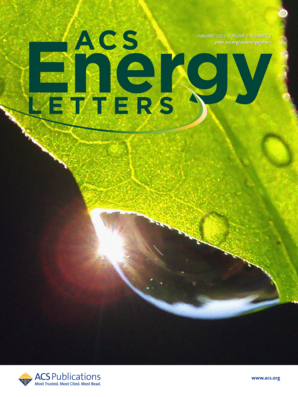精确调节六苯并硼烯基 MOF 的带隙以增强光催化性能
IF 19.3
1区 材料科学
Q1 CHEMISTRY, PHYSICAL
引用次数: 0
摘要
在光催化过程中,精确调整金属有机框架(MOFs)的带隙对于提高其可见光吸收能力至关重要,这既是一个艰巨的挑战,也是一个迷人的机遇。本研究采用对称还原策略,预先设计了六种具有系统取代基(-NO2、-H、-tBu、-OCH3、-OH 和 -NH2)的新型 4 连接配体,并合成了相应的保留六苯基苯片段的柱状层 Zr-MOFs (NKM-668)。随后,通过 Scholl 反应将 NKM-668 MOF 转化为大-π-共轭六苯并硼烯基 MOF(pNKM-668)。这十二种 MOFs 的带隙超过 1.41 eV(从 3.25 eV 到 1.84 eV),具有宽带隙和可调性,光催化 CO2 转化率提高了 33.2 倍。这项研究不仅丰富了六苯基苯基MOFs的种类,而且为含纳米石墨烯的MOFs在光催化领域的进一步应用铺平了道路。本文章由计算机程序翻译,如有差异,请以英文原文为准。
Precisely Tuning Band Gaps of Hexabenzocoronene-Based MOFs Toward Enhanced Photocatalysis
Precise adjusting the band gaps in metal-organic frameworks (MOFs) is crucial for improving their visible-light absorption capacity during photocatalysis, presenting both a formidable challenge and a charming opportunity. This present study employed a symmetry-reduction strategy to pre-design six novel 4-connected ligands with systematic substituents (-NO2, -H, -tBu, -OCH3, -OH and -NH2) and synthesized the corresponding pillared-layer Zr-MOFs (NKM-668) retaining the hexaphenylbenzene fragment. Subsequently, the NKM-668 MOFs were transformed into large-π-conjugated hexabenzocoronene-based MOFs (pNKM-668) via the Scholl reaction. These twelve MOFs exhibited broad and tunable band gaps over 1.41 eV (ranging from 3.25 eV to 1.84 eV), and the photocatalytic CO2 conversion rate raised by 33.2-fold. This study not only enriches the type of hexaphenylbenzene-based MOFs, but also paves the way for nanographene-containing MOFs in the further application of photocatalysis.
求助全文
通过发布文献求助,成功后即可免费获取论文全文。
去求助
来源期刊

ACS Energy Letters
Energy-Renewable Energy, Sustainability and the Environment
CiteScore
31.20
自引率
5.00%
发文量
469
审稿时长
1 months
期刊介绍:
ACS Energy Letters is a monthly journal that publishes papers reporting new scientific advances in energy research. The journal focuses on topics that are of interest to scientists working in the fundamental and applied sciences. Rapid publication is a central criterion for acceptance, and the journal is known for its quick publication times, with an average of 4-6 weeks from submission to web publication in As Soon As Publishable format.
ACS Energy Letters is ranked as the number one journal in the Web of Science Electrochemistry category. It also ranks within the top 10 journals for Physical Chemistry, Energy & Fuels, and Nanoscience & Nanotechnology.
The journal offers several types of articles, including Letters, Energy Express, Perspectives, Reviews, Editorials, Viewpoints and Energy Focus. Additionally, authors have the option to submit videos that summarize or support the information presented in a Perspective or Review article, which can be highlighted on the journal's website. ACS Energy Letters is abstracted and indexed in Chemical Abstracts Service/SciFinder, EBSCO-summon, PubMed, Web of Science, Scopus and Portico.
 求助内容:
求助内容: 应助结果提醒方式:
应助结果提醒方式:


